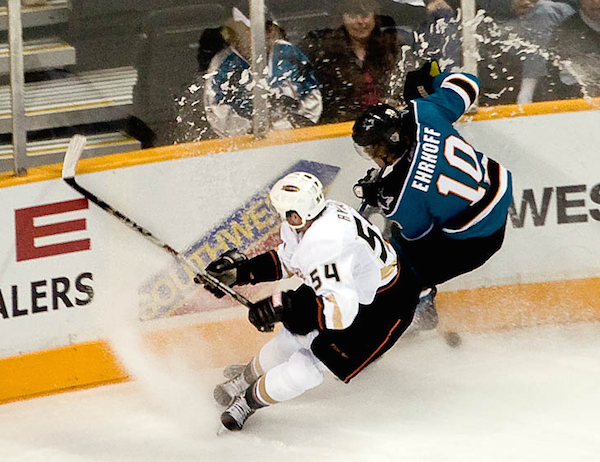Dear Sports Fan,
How does icing work in hockey? No matter how much hockey I watch, I continue to be confused by icing. It seems like the refs will just randomly blow the whistle sometimes when the puck gets shot down the rink and then the announcers say it’s icing.
Thanks,
Gil
Dear Gil,
In hockey there are two types of calls that the refs make. There are penalties and then there are infractions. When the ref calls a foul, he or she sends one or more players off the ice into the penalty box for two or more minutes. Infractions are for lesser offenses. They are like the misdemeanors of the hockey world. Of all the infractions, icing is perhaps the most important one. In this post, I’ll explain what icing is and why it is so important in hockey.
Icing happens a player sends the puck directly from their side of the rink all the way past the goal line on the opposite side of the rink without one of the player’s teammates touching the puck and without any player on the other team having had a chance to play the puck. The team that shot the puck down the ice is penalized for icing the puck by bringing the puck all the way back to their defensive zone to restart play. Additionally, the team that has violated the icing rule is not allowed to change players while the other team can. As you might be able to guess from the rule’s description and penalty, icing is a rule designed to slant the game towards the offense by constraining the defense. Without the icing rule, a team trapped in their own end of the rink, frantically playing defense, would be able to blindly shoot the puck the length of the ice to relieve the pressure the other team is putting on them. With the icing rule, a team that does this is stuck with the same (usually very tired) players on the ice while their opposition gets to roll out a fresh set of players to set up on offense.
One thing that’s a little bit tricky about the icing rule is that it is not based on intent, only geography. It makes no distinction between a desperate defensive player who flings the puck all the way from their own goal line and a player skating up the rink on offense who dumps the puck into their offensive zone intending to retrieve it, but lets the puck go just inches on their side of the ice by mistake. Both players would be called for icing but the second scenario is much harder to see. That could be why the rule seems random to you.
Before we go into why the rule is so important, there are two key wrinkles we should cover. First — a team that is on the penalty kill (is playing with fewer players on the ice because of a penalty or series of penalties) is exempt from icing. Down a man, they can throw the puck all the way down the ice with a clear conscience. Second — it used to be that icing would not be called until the team not icing the puck had skated back to their end of the rink and touched the puck. That led to some exciting races, because remember that if a teammate of the player who iced the puck touches it first, it’s not icing. Unfortunately, it also led to a lot of horrible injuries. Normally players will let up a little if they are skating directly into the boards, but if an icing call was at stake, they didn’t. Two players, skating full speed towards unforgiving boards is not good. So, in 2013, the NHL finally adopted the “no-touch” icing rules that were prevalent in other leagues. These rules dictate that when a puck has been iced, the icing team can still race to negate the icing penalty but the end point of the race is the red face-off dot closest to the puck, not the puck itself.
Icing calls are frequently pivotal in a hockey game because, second to fouls that give one team a numerical advantage, icing is the most punitive rule in the sport. Hockey is not nearly as territorial as, say, American Football, but having a face-off in a team’s offensive zone rather than the neutral zone or defensive zone can be a big deal. The fact that icing creates this situation while also giving the offensive team an opportunity to substitute players while the other team cannot, can be a very big deal. If you want to do a little study, watch a few hockey games and keep track of the number of times your team gets a legitimate scoring chance directly from an offensive zone face-off following an icing call, versus any other offensive zone face-off. My guess is that icing will result in a much higher percentage of scoring chances.
Thanks for reading,
Ezra Fischer

